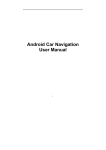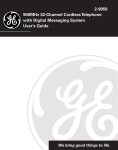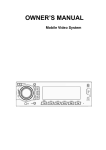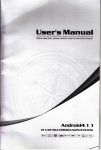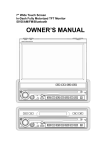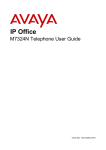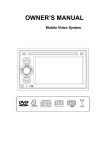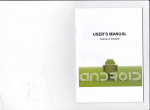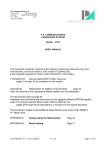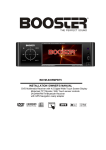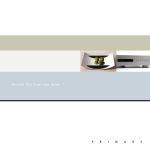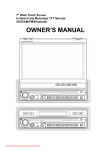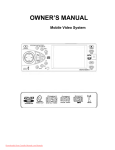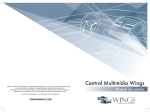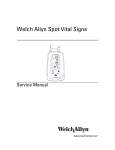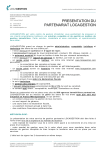Download Android Car Navigation User Manual
Transcript
Android Car Navigation User Manual The use of certain features of these devices depends on your network service provider's network settings and performance. In addition, due to the different network service providers, some certain functions of this device may not be able to apply or restrict to apply. And please contact your network service provider for consulting the network functions and availability of this device. This mark indicates that the product uses a label which is classified CLASS1 laser, indicating that the device uses the weakest level of laser beam, and there is no risk of radiation outside the unit. Note: Do not expose the batteries to extreme heat. Put the plug in place easy access to it always. 2 Contents Contents.........................................................................................3 1. Quick Review......................................................................................5 1.1 Turning On and Turning Off..................................................5 1.2 Panel Function Button..........................................................5 1.3 Tips for Using Touch Screen................................................6 1.3.1 Clicking Function........................................................6 1.3.2 Pressing Function........................................................6 1.3.3 Dragging Function.......................................................7 1.3.4 Zooming Function .....................................................7 1.4 Main Screen.............................................................................7 1.5 Status bar indicator................................................................8 1.6 Time and Date Setting............................................................8 1.7 Text Inputting. .........................................................................9 2. Function Operations.......................................................................10 2.1 Basic Settings........................................................................10 2.1.1 User Defined Home Screen.....................................10 2.1.2 Setting Wallpaper......................................................11 2.1.3 Shortcut.......................................................................11 2.1.4 Widget...........................................................................11 2.2 General....................................................................................12 2.2.1 Steering Wheel...........................................................12 2.2.2 Screen Calibration...................................................13 2.2.3 Navigation application..............................................14 2.2.4 Factory settings..........................................................14 2.3 Navigation..............................................................................15 2.3.1 Navigation Software Installation............................15 2.4 Radio........................................................................................17 2.4.1 Radio............................................................................17 2.4.2 RDS................................................................................19 2.5 Bluetooth Wireless Connection.........................................19 2.5.1 Startup bluetooth application.................................20 2.5.2 Bluetooth pairing........................................................20 2.5.3 Bluetooth Phone Book..............................................21 2.5.4 Phone............................................................................22 3 2.5.5 Call Record..................................................................23 2.5.6 Bluetooth Music.........................................................24 2.5.7 The whole Bluetooth hardware settingss............24 2.6 3G Application........................................................................25 2.6.1 Allow data roaming...................................................25 2.6.2 Set the access point information...........................25 2.7 WLAN........................................................................................31 2.8 Multimedia...............................................................................33 2.8.1 Equalizer.......................................................................33 2.8.2 DVD Play.......................................................................34 2.8.3 CD Play.........................................................................35 2.8.4 IPod Play.....................................................................36 2.8.5 Audio Play...................................................................38 2.8.6 Video Playing..............................................................39 2.8.7Picture Browse............................................................40 2.8.8 Digital TV......................................................................43 2.8.9 Analog TV...................................................................43 2.9 AUX IN Function....................................................................43 2.10 Rear View..............................................................................43 2.11 E-mail......................................................................................44 2.11.1 Email Setting............................................................44 2.11.2 Sending E-mail..........................................................46 2.11.3 E-mail input................................................................47 2.12 Message Functions............................................................48 2.12.1 Compose New Mails...............................................48 2.12.2 E-mails Reply............................................................49 2.13 Applications.........................................................................50 2.13.1 Weather......................................................................50 2.13.2 Calculator...................................................................51 2.13.3 Electronic reader.....................................................51 3. Firmware Upgrading.......................................................................52 3.1 Preparing for upgrade..........................................................52 3.2 Update MCU............................................................................52 3.3 Update system................................................................53 3.4 Update DVD...................................................................53 4. Trouble handle................................................................................53 5. Specification.............................................................................56 4 1. Quick Review Warning: Before using this device, please read the manual safety and law information. 1.1 Turning On and Turning Off Turning On Turning Off When you plug in the car keys, open the car's ACC power, the device will be automatically turned on, displaying the boot animation LOGO. When you take off the key, turn off the car's ACC power, the device will automatically be shut down. 1.2 Panel Function Button Icon Button PWR/VO L Power/ Volume HOME Main Interface MENU Main Menu BACK Back NAVI DVD Navigation DVD Play Function ① When power off, short press this button, the system is switched on ② In the boot state, press this button short, the system becomes mute; long press this button, the system is shutdown ③ Turn this button clockwise, the volume is increased ④Turn this button counterclockwise,the volume is decreased ① Click to enter into main interface ②Long press for 3secs to show the running function ①In each function, for extended manipulation of information, press the MENU key to pop up ② In main interface, press the MENU key for the system to quickly set functions ①Click to get back to the last interface ②Long press for 3secs to quit the running function Click to enter into GPS navigation interface Click to enter into disk play interface 5 PHONE PHONE RADIO RADIO TUNE Compound SD USB RESET MIC In/Out Disc Button SD Media Card slot USB Socket Reset Button Microphoe ① Click to enter into Bluetooth telephone interface ②Bluetooth dailing keyboard will pop up by long pressing this button in other function interfaces. Phone will be hung up by short press Click to enter into radio interface for receiving FM1/FM2/ AM radio ① In the audio and video playback interface, up / down one player ②In the radio interface up / move down frequency Disk in and out Insert the appropriate memory card, multimedia file system can read the card ① Connect other devices by USB socket. ② Connecting an external WIFI/3G dongle Click reset button to reset system and re-start. Receive voice from bluetooth telephone call. Remark: All long press means press time at least lasting 3 seconds; Please noted button and socket are different according to different car types. 1.3 Tips for Using Touch Screen When using the touch screen, you can use several ways to perform corresponding operations on the device. 1.3.1 Clicking Function You could select an application icon or option on the screen to use clicking function. For example, click Bluetooth to enter into bluetooth application. 1.3.2 Pressing Function You could press the current user interface, icon, and inputting column by pressing function. For example, 6 press on the blank area of the main interface, then comes a pop-up menu, you could perform some function on the menu. 1.3.3 Dragging Function Drag the touch screen or press the scroll bar for up and down operation. For example, browse the contact list of the bluetooth phones by dragging function. 1.3.4 Zooming Function When browsing the web, click the screen twice, then you could zoom in or out the page content. Or you could press the screen with two fingers by control the sliding distance between the fingers to zoom in or out the page content. 1.4 Main Screen You can use the touch screen operation to use the various functions of the device. This equipment has a total of five main screens, and left or right sliding can be switched with each other. In any interface, press the HOME physical buttons on the panel to return to the main screen interface, display the application icon in the main screen interface, and click any application icon to open the program. Note: You can add or remove programs in the main screen to customize your unit. Click the application icon and you can view all of the 7 programs preinstalled. 1.5 Status bar indicator Icons on the left top of the screen are notifications for messages and events; Icons on the right top of the screen are device status indicator. If there is new message, it will be displayed on the status bar, slide your finger gently from the status bar, all prompts would be displayed. Then you could click the message and view the content. Indicators on the left Description Indicators on the right Network signal strength New Message Description Network signal USB connection instructions Current Time indication WIFI signal indicator Tip: You can tap and hold the status indication bar to view the current date. Note: The device software is under upgrading, the status indicator may be different with your device; please refer to the actual device software. 1.6 Time and Date Setting This device has the function to automatically calibrate the current time when GPS is active. You could also manually set the date, time zone and format. Applications> Settings > Date and Time > Setting Date or Setting Time Tip: You can set the time zone and time format according to request. 8 1.7 Text Inputting When editing text, you could use existing inputting method and Android keyboard to edit English, numbers, and symbols etc., such as editing message, searching key words etc. Tip: The display format would be different according to different status and keyboard of the entering. Please refer to the actual status. 1.7.1 Switch on the Inputting Method Open the text editing interface Click in the editing area, then the editing menu would appear. Click the input method, you can choose the Android keyboard or install third-party input method. 9 1.7.2 Android Keyboard Input Switch the input method into Android keyboard (see switch input method) Remark: You can click the number sign key switch to numbers and symbols input mode. to switch letter case. Click to 2. Function Operations 2.1 Basic Settings 2.1.1 User Defined Home Screen There are 5 main screens of this device, sliding left or right to switch. In any interface, you just need to click the HOME to get back to main screen. Note: You could add shortcut, widget and file in the 10 blank area of the main screen on the condition that there is enough room for placing. 2.1.2 Setting Wallpaper Click the blank area of main screen> Wallpaper > Wallpaper or Pictures Bank Choose your preferred wallpaper and click to set as wallpaper. 2.1.3 Shortcut Click the blank area of main screen> shortcut > Choose Shortcut Click the shortcut needed. 2.1.4 Widget Click the blank area of main screen> Widget > Choose widget Click the widget needed. 11 2.2 General 2.2.1 Steering Wheel Users could set the steering wheel according to hint. Note: Steering wheel interface is special for cars with buttons, but some cars’ steering button are not able for learn but by “canbus”, such as Ford MONDEO Application>Setting > General Settings > Steering wheel Settings Steering Wheel Interface 12 a. First to click “Start” b. Click the buttons as you want. c. Press the corresponding button on the wheel. If the study displays successful, there will be a change on the corresponding color on the main screen. d. Repeat step 1 and 2 till you complete all the buttons’ setting on the steering wheel. e. Click “END” to ensure that the steering wheel setting is completed. If you want the steering wheel button to re-learn, press the [CLEAR] and repeat a, b, c, three steps. 2.2.2 Screen Calibration Applications> Settings > General Settings > Touch screen calibration Enter the calibration to calibrate the screen interface. Please click as close as possible to the cross until a successful calibration, then exit the calibration interface. 13 2.2.3 Navigation application Select appropriate map application, then it can be associated with the navigation button on the physical and navigation icon on the main screen. Applications> Settings > General Settings > Navigation options > For example: IGO 2.2.4 Factory settings When the system is unable to work or problems occur after user used the system, it can be restored to the factory settings. Once it’s restored to factory settings, all the third-party software would be deleted, and the current system settings would be lost. For navigation software, just need to install corresponding APK. Please operate carefully. Applications> Settings > General Settings > Factory settings 14 2.3 Navigation 2.3.1 Navigation Software Installation 1. Copy the application program with suffix name “APK” to SD card or U disk. There are two installation methods: Click into the document management interface to find SD card or U disk directory and select “APK” application, and click install directly. File Management Interface Applications> File Management Interface > Expansion card or U disk Extra Interface->Application Program->Install Application Program Select the application program with suffix named “APK” and install. Application Program Interface Application > Settings > Applications > Application Program Installation 15 Note: Please copy the navigation map software to the system storage memory first, and then install the navigation APK. Steps are as follows: 1) Insert navigation data packets to SD card or U disc 2) Start the ES file browser (or other document management software ) 3) Enter the" /sdcard/extsd" ( SD) or" /sdcard/udisk" ( U ) directory, find the navigation packet directory ( for example: NaviOne (Kelid navigation ) ), and select Copy command according to the catalog in the pop-up menu. 4) Go back to the "/sdcard/" directory, choose the paste command 16 5) Copy completed (30 mins approximately/3.5G ). After successful installation, select the navigation program you need, associate panel physical keys NAVI to it and the interface of the navigation application icon in main menu. (See 2.2.4navigation options). 2.4 Radio 2.4.1 RADIO Press the RADIO button on panel or click the icon on the main menu to enter the radio interface, the specific functions and operations are as follows: Radio Interface 17 The functions of Icons in the radio interface are described below: Icon Button Name Band Switching Search Channel Backwards Search Channel Forwards Scan all Channels Locate and DX Audio settings list of radio stations Forward tuning Back tuning Main Menu Back Automaticall y search Function Description Click BAND to switch between mode FM1/FM2 /AM Click to search channel backwards then stop when find clear channel Click to search channel forwards then stop when find strong and clear channel Scan automatically and save channels(Coupled with a scanning radio signals broadcast for 10 seconds, no signal of the radio scan play 3 seconds) Change between locate and DX models Click enter the EQ setup List of radio stations, according to the storage for the playing frequency point Forward tuning radio Backward tuning radio Click to back to main menu Click to go back to last interface Search and save band automatically 18 2.4.2 RDS Radio interface with RDS Icon details as below: Traffic Annou nceme nt Alterna tive Freque ncies Progra m Type Region al Link Click TA symbol to light up, and it can source automotive the station which can broadcast traffic information. The system will source every minute, it will stop to display traffic matter when we get the news, and it will directly go back to the situation after traffic information displays When click AF to light it up, RDS can swift to the station which has stronger signal when the frequency is weak, but the content of RDS station will not change, yet just move to the other frequency. It only sources RDS station. When click PTY to light it up, RDS radio displays the station type info once it receives RDS station, and the corresponding PTY information is automatically displayed Click REG symbol, it will only search the RDS stations with the same national area code (PI 8-bit representation of the high country area code) of the current RDS station. If REG is not highlighted, you can search RDS station while ignoring the area code (excluded the high 8-bit PI code ) 2.5 Bluetooth Wireless Connection You could create a wireless connection between a mobile phone and this device for phonebook and music. Note: There may be prohibition or restriction for Bluetooth devices, please follow local laws In order to ensure bluetooth security by the greatest degree, you should be in safe and non-public place when connecting a bluetooth device. 19 2.5.1 Startup bluetooth application Under the default status, the bluetooth would be turned on when the power is connected. Panel "PHONE" key to quickly enter the Bluetooth interface; 2.5.2 Bluetooth pairing The whole information of the Bluetooth interface, the mobile search auto-complete matching (the default passkey: 0000) Matching refers to the mutual recognition process of two Bluetooth devices for the first communication. After the first connection, the subsequent communication connection will automatically pair and not have to pair every time (Depending on mobile phones). Press in Bluetooth pairing interface, it will get into the status of the Bluetooth search mode and this machine is searching for Bluetooth devices around, press terminate the search state. again will automatically Choose the Bluetooth device name on the search results to match connection. It will automatically after the connection is successful jump to the matching list, and there will be a Bluetooth icon besides the successful connected Bluetooth devices 20 Note: The following operations are performed in the Bluetooth pairing success status. 2.5.3 Bluetooth Phone Book In the Bluetooth interface, click “ ” to enter the Bluetooth Address book interface, and follow the download the phone book. A list of dial-up operation when long names and numbers are used to scroll the display Bluetooth Phone Book Interface 21 Download the phone book Again after the download is complete, clicking the phone is the search function Download Mobile phone SIM card phone book Again after the download is complete, clicking the phone is the search function Download all mobile phone book Delete all phone book imported. 2.5.4 Phone 2.5.4.1 To achieve the dialing function via Bluetooth In the Bluetooth interface, click “ ”to enter into the Bluetooth Dial interface. Bluetooth phone Dial Records Interface ① Click numbers on the interface, if the input is wrong, click to delete ② Click after entering phone number; Click to end up the call. ③ When in a call, press to switch to the phone to mute for MIC. call, press ④ Function keys on the panel are unavailable when in the call; the function keys return to normal after hang up. 2.5.4.2 To achieve the ‘being called’ function via Bluetooth 22 When the mobile phone is connected with Bluetooth device and there is an incoming call, the interface is divided into two situations: ① In the Bluetooth Application Interface ② In other function interfaces Note: Click the call is to pick up the phone, and click means to hang up, then the small window will automatically disappear. 2.5.5 Call Record ” to enter into In the Bluetooth interface, click “ bluetooth call history interface. Click for doing dial operation, 23 Call recording interface Remark: When the names and numbers are long, they would be displayed rollingly. Missed calls Received calls Dialed calls Delete all call information 2.5.6 Bluetooth Music In the Bluetooth interface, click “ ” into Bluetooth Music Interface. When connected with bluetooth mobile phone, it can operate play/pause/down music function. Bluetooth Music Interface Note: Some kinds of mobile phones need to start playing music player for bluetooth music when using bluetooth music function. 2.5.7 The whole Bluetooth hardware settings Bluetooth interface, enter the Bluetooth settings screen. 24 The whole phone name Pair settings Click to back to main menu. Click to go back to last interface. Back to matching the main interface 2.6 3G Application Applications> Settings > Wireless and Network > Mobile network > Access Points 2.6.1 Allow data roaming Applications> Settings > Wireless and Network > Mobile network ① Click data roaming, select OK. ② If the recognition is successful, the access would automatically identify the type of 3G device to populate the appropriate access, as shown below: Note: please confirm data roaming open; otherwise you cannot use the 3G function 2.6.2 Set the access point information Before using 3G function, make sure 3G dongle connected to the USB port with a 3G card inserted in. 25 a. Enter the system main interface, b. Select the "Settings" to enter the main interface. c. Select "Wireless networks", access to the network selection screen. d. Select Mobile networks, and enter the ‘mobile network’ settings of the main interface. 26 e. First make sure the data roaming ‘Data roaming’ is selected, if you have no choice, point the" Data roaming "pop-up prompt menu, select" Ok ", f. Results shown in Figure 7 aftering successful selection: g. Set the ‘Access Point Names’, enter the name of the network access point settings to the main interface. 27 h. Press the ‘Menu’ button on the machine panel, pop-up menu option. i. Select ‘New APN’ new ‘APN’ into the ‘APN’ to set the main interface. j. Select the "Name" to set APN name. "Name" can be randomly set, and when input is complete, select "OK" to finish. 28 K. Select "APN", enter "the Apn access name in the Chinese mainland of China Unicom's 3G the APN settings for:" 3gnet "in Hong Kong, Macao and Taiwan and foreign, should be consulted local 3G network supplier, enter the correspondingAPN value. 29 l.Press the "Menu" button on the machine panel, pop-up menu option. m. Select "Save" to save the settings content, and return to the main interface of Apn settings n. When the following interface pops up, make sure that Step 1 is complete, press Home to return to the main interface, then repeat 1-15 steps: 30 o. In the Apn the main interface, select New APN network behind the circle, so that it is selected can. p. Back to the main interface, the3G network has opened, the search to the 3G signal, can use3G network. 2.7 WLAN You can use the WLAN high-speed Internet access and download. Applications> Settings > Wireless & networks setting USB ports using guide: 1. The front USB and rear USB can not be plugged by U disk at the same time, orelse the U-disk won't be read. 2. Normally the front USB port is defined to connect U disk while the rear USB port to WLAN and 3G dongle 1. Open WI-FI device 2. WI-FI settings search, WI-FI is open, the device will automatically scan the network, listing all of the network within the search range 31 3. Click on the link to the connectivity of the network 4. If required, enter wireless password, click on the link, as shown below: The first input password to connect successfully, then don't do this, reboot the system will automatically connected to a matching wireless network. 32 Successful connection interface 2.8 Multimedia 2.8.1 Equalizer Applications > Equalizer Click equalizer application icon into the equalizer interface. Or click to enter into EQ Setup operation in all audio or video playing interface. Equalizer settings interface is divided into two functions: namely, equalizer and sound field settings function. ① In the equalizer settings interface, it provides 8 kinds of audio playback mode to choose: Equalizer settings interface Note: In the Normal mode, users can customize effects model through the effect adjuster. ② In a field setting interface, the user can freely adjust the bass and loudness of the contrast, to the front left, 33 front right, rear left, and rear right after the four angularly audio settings, as shown below: Balance Setup Interface Note: the subwoofer adjustment is only effective when it is linked to external 5.1 amp. 2.8.2 DVD Play Insert the DVD disk the system will automatically enter the DVD interface and read the disk information automatically when a disk is detected and then start to play normally. DVD Play Interface Function details as below: 34 Icon Button Name Function Description Play/Pause When playing, click it to pause. When pause, click it to continue playing. Next Track Click to play the next track or next chapter. Last Track Click to play the last track or next chapter. Fast forward Fast Backward Click to fast forward increasingly as by 2X / 4X / 8X / 20X DVS: Click to fast forward increasingly as by 2X / 4X / 8X / 16X / 32X Click to fast rewind increasingly as by 2X / 4X / 8X / 20X DVS: Click to fast rewind increasingly as by 2X / 4X / 8X / 16X / 32X Extended function Used to eject the expansion function Title Click to show title (need disk support) Cycle Play Mode Random play mode Channel Switch Subtitle EQ Setup Main Interface Back Click to set up playback mode, DVD: Chapter cycle / heading cycle / full catalog circulation / cycle cancellation; VCD : single cycle / all cycle / cycle cancellation. Options for ON and OFF, ON, switch on the next song, random play Click to switch in different languages and audio tracks (need disk support). Click to switch subtitle display(need disk support) Click to enter into EQ setup interface. Click to back to main interface. Click to back to the last interface. 2.8.3 CD Play Insert a CD disc, the system will automatically enter the CD interface. When a disc is detected, it will automatically read the disc information and start normal play. 35 CD Play Interface Icon Button Name Function Description Play/Pause Click to play or pause. Next Track Cycle Play Mode Random play mode At one time to play the next song, press down roll list for tracks Click to set up playback mode Click to set the random playback mode Last Track Click to play the last track or next chapter. EQ Setup Click to enter into EQ setup interface. Click to go back to main menu. Main Menu Click to go back to the last interface. Back Function details as below: 2.8.4 IPod Play Application> iPod Click the iPod application icon to enter into the iPod play interface, just as shown below. 36 iPod Play Interface Function details as below: Icon Button Name Play/Pau se Function Description Click to play or pause. Next Track Click to play the next track. Last Track Click one time to replay the current track; Click twice to play the last track. Fast Forward Press to fast forward. Fast Rewind Press to fast rewind. Cycle Play Mode Random play mode Click to set up play modes: sequential play, single cycle, the whole catalog circulation. Click to start random play mode or cancel random play Artist Click to play the iPod's song in the form of an artist. Album Click to display the iPod’s song in the form of album. Song Click to display all the songs in the iPod. Play List Click to display the listed songs in the iPod. 37 2.8.5 Audio Play Audio player supports the following formats: mp3/aac/flac/wav/amr/m4a/ogg Application>Music Click music application icon to enter into the music player interface, as shown below: Artist Interface Music Play Interface Function details as below: 38 2.8.6 Video Playing Icon Button Name Play / Pause Function Description Click to play or pause Next Track Play the next track Last Track Play the last track Cycle Play Mode Click to set up play mode: sequential play, single cycle, the whole catalog circulation Random Play Play List Artist Album Songs Play List Click to start or cancel random play. Click to display the most recently added songs. Click to play all the song as if to be performed by an artist. Click to display all the songs in the form of album. Click to display all the songs. Click to display the most recently added songs. Supporting form of the video player: mp4/avi/wmv/3gp/flv/saf/mov/mkv/mpg Application >Video Press Video application icon to enter into video playing interface, for example. 39 The detail of the button function of video playing Icon Button Name Play/Pause Function Explanation Press Pause when play Press Play when pause Forwards Fast Click to forwards fast Backwards Fast Click to backwards fast interface 2.8.7Picture Browse Applications > photo Album. Click the symbol under the application menu to enter into picture browse interface, the detail as below. Picture Browse Interface Click to get back and you can move the 40 picture at random or click pictures right and left. Click symbol shown as below. to move Picture Browsing Interface (Customized display) Click any picture enter into single picture display mode, shown as below. To move the picture left and right by one’s hand to view the photo, under the normal states to double-click the photo to change the photo’s size. Click to enter into the browsing mode for all photos. Click other function operation. 41 , it will change for Single Picture Display Interface (Other Function Operation) Function Explanation, Icon Bottom Name Delete Detail Setting Setting Trim Rotate Left Rotate Right Function Instruction To delete the selected picture. Click to show title, type, shooting time, photo album and place on the picture. According to your choice to setup image screen According to your choice to trim it. According to Auticlockwise to turn picture for 90 According to clockwise to turn picture for 90 Note: Insert and plug SD card when power on is prohibited, otherwise it may cause data loss. 42 2.8.8 Digital TV Application > Digital TV Click analog TV application icon into the digital TV interface The details of digital TV function interface are as below. Note: For more details of description of the digital TV, please Icon Button Name Function Explanation Menu Click to back into menu Back Click to back into last content EQ Click to enter into EQ interface refer to the digital TV instruction. 2.8.9 Analog TV Application > Analog TV Click Analog TV Icon to enter into Analog TV playing interface. 2.9 AUX IN Function Make sure video source is under the normal state of output in this function. Application > AUX IN Press screen to come out a hide menu, click to enter into EQ setting interface, it can adjust EQ effects. Click click to get back into last interface, to get back into system menu. 2.10 Rear View When the car starts reverse gear and if with a mirror, 43 the system switches to the rear-view mirror screen output automatically, and keeps audio output sound; if not equipped with rear-view mirror, the system remains the same video playback. 2.11 E-mail Users could use “Email” to send or receive email mess age. Note: Email messages could be sent and received based on the connection of Internet. Please contact your network service provider for the detailed setting parameters. 2.11.1 Email Setting Application > E-mail Enter a email address and password, then click next step to set account name, your name and signature, then click finish. Users could also manually set the email account: 1. Enter email address and password; 2. Click to manual set, andselect the type of E-mail account. (For example: POP3、IMAP、Exchange) 44 3. Set the receiving server, port, and etc. 4. Set the outgoing server, port, etc. 5. Establish the new account 45 6. Enter E-mail Interface 2.11.2 Sending E-mail You can give one or more recipients to send mail. You can manually add the recipient and choose from your address book before sending E-mail. Application > E-mail Press the "MENU" panel, message editing screen 46 open the mail 1. It needs to input recipient, click recipient, and put in recipient e-mail address. If necessary, press the panel "MENU" and select menu " " function keys> Add Cc / Bcc, enter the Cc or Bcc recipient address. 2. Click the topic, enter a subject, click the letter input area, enter the desired content. According to the panel "MENU", the pop-up function keys, add an attachment , select the desired option, and insert the required documents 3. Click “ ” to send E-mail 2.11.3 E-mail input Application > E-mail Press the “ ” in “MENU” or use the mouse to slide 47 to the end of inbox and click “ ”. 1. Instruments link the server and download the E-mails, and then save the received E-mails information in the inbox. a. Choose the E-mail you needed so that you can read it. b. Press “MENU” key when you are reading the E-mail and click “ Forward” to transfer the E-mail to the other customers or click “ reply” directly, edit the message and send the E-mail to the sender. 2.12 Message Functions You can send and receive short messages or MMS which contains multimedia documents. 2.12.1 Compose New Mails 48 Application> information >Messaging Button >New message Enter into the interface of composition, and follows as below. 1. Input the E-mail receiver 2. Input the words information you want to send. 3. Click “send” and send the E-mails 2.12.2 E-mails reply When you receive new inbox, instructions column will display at the top of the computer and issue the prompts. Application> information After click “Corresponding information” 1. Click the “version input area” 2. Edit your replied information in the version input 49 area and click “Reply-and-send” E-mail. 2.13 Applications 2.13.1 Weather Application> Weather Interface> long press interface >Widgets >Fancy widgets 4*2 Enter the region selection, in the input box, enter the query you want to determine the area, click the icon to search as shown in the figure: 50 Search interface 2.13.2 Calculator Application> Calculator There are two display panels, basic and senior on the calculator. Press MENU> senior or basic, or move from left to right, to chance freely between the two panels. Note: press MENU> delete the record 2.13.3 Electronic reader According to the user’s requirement to install the electronic reader, users can also install the third party reader software. Note: The system's user manual is placed in the electronic reader. 51 3.Firmware Upgrading 3.1 Preparing for upgrade 1. First, format your SD card for what you use to firmware upgrade. 3.2. Update MCU 3.2.1 copy "318a2e70-44bf-11e1-b1cf-000c29ba27c0" to the root directory of SD card,and Inserted into the machine SD card slot. 3.2.2 Start to update MCU(Settings->General->MCU update),click OK 3.2.3Wait for the upgrade is completed. The system will automatically restart after the upgrade is completed, please don’t Ignition or shut down during the upgrade process. 52 3.3 Update system 3.3.1. copy "u-boot-skip.bin、uImage、uramdisk.img、 system.img" to the root directory of SD card,and Inserted into the machine SD card slot. 3.3.2、Shutdown 3.3.3. Press and hold any panel buttons,and boot,the system will enter the upgrade interface automatically. 3.3.4 The system will automatically restart after update. (The system will enter the touch screen calibration interface after the restart, please complete it.) 3.3.5、If one or more errors occur, please Ignore and repeat step 2 to step 4. 3.4. Update DVD 3.4.1 Burn "dvdrom.bin" to CD-ROM,and inserted into the machine dish mouth 3.4.2 Wait for the update is complete. 3.4.3 Eject the disc 4. Trouble handle When your equipment meets troubles, please check the problems as below. 53 Ite m Problem Solution 1 Unable connect to the network ① See 3G Card is installed correctly ② to make sure the correct and proper 3G terminal operator’s SIM card ③ weather launched 3G card data ④ Mobile data roaming setting is connected or not. ⑤ APN weather selected ⑥ Whether 3G card arrears 2 It can’t to save and mention “MCC” must have 3 letters Check the 3G card install right or not. 3 Can’t install applications 4 After the Bluetooth paired successfully, it mentions connection fails 5 How to install applications ① Verify that the install application suffix is named “APK” ② Enter into Setting to select unknown sources A. Some cellphones with Android system may occur when first connect. Please just find the paired device in matching list and then connect them once more. B. The unsuccessful connection is compatibility issues between cell phone and Bluetooth. If this occurs, please check the options in pair list of your cell phone. And you will find that the setting of Bluetooth Media and Mobile Media has been turned off. Turn on them and the connection will be successful. First, please copy the application files with suffix ".APK" to your SD or U disk. And the following are installation methods: 1. Click into the document management interface to find the SD card or U disk directory, and then select the ".APK" suffixed application file and click to install. 2. Find the Setting interface—>Applications—>install application, 3. Select the ".APK" suffixed file and click to install. 54 6 7 8 9 10 11 12 13 How to uninstall users APK application Radio can’t research channels No sound Media can’t be recognized from SD card. 3G、WIFI can’t be recognized MUSIC, RADIO and third-party application mixes, can not turn off the MUSIC, RADIO Press NAVI to enter navigation. Pressing again is not able to go back to HOME or quit. No keyboard pops up when dialing and receiving calls in other functions interfaces except Bluetooth Interface Setting—>Applications—>Installation Applications—>Uninstallation Applications. To click the uninstallation of APK Applications Check the radio antenna whether it’s connected and it has signal before using it. Check if system is muted Prohibit hot-swappable SD card (Do not insert or plug SD card when power on) Prohibit hot-swappable 3G/WIFI (Do not insert or plug dongles when power on) Long press panel Back to exit the system MUSIC RADIO mode, again into third-party applications can In android system, the button HOME can guide you from navigation interface to main menu. Therefore NAVI is only defined as entering instead of quitting. Long pressing the button PHONE will go directly to Bluetooth dialing interface; short press to hang up the phone call. 55 5. Specification Operating voltage: DC 12V Operating voltage range: 10.8V ~ 16V Maximum operating current: 10A Installation size:150*178*100mm Installation angle: The front and rear inclination is less than 30° FM radio part Frequency range: 87.5-108MHz (Europe) 87.5-107.9MHz (America) 36 stations preset Sensitivity (-30dB):12dBu SNR (-50dB):15dBuV Frequency response range: 30Hz~15KHz (±3dB) AM radio part Frequency range: 522-1620KHz (Europe) 530-1710KHz (America) 18 stations preset Sensitivity (SN=20dB): 20dBuV Mirror-image suppression: 60dB Frequency response: 50Hz ~2KHz (±3dB) DVD/CD play part Compatible discs and format: DVD-R, DVD-RW, DVD+R, DVD+RW, CD-R, CD-RW, CD-DA, MP3, WMA, SVCD, VCD, MPEG, JPEG Audio SNR: 85dBA Dynamic range: 95dB Frequency response:50Hz ~2KHz(±3dB) Digital audio sampling: 24bit Electronic shock protection (ESP): DVD 2~ 3 seconds CD-DA 10s MP3 100s WMA 200s Mechanical shock protection: 10~200Hz, X/Y/Z:1.0G Power output: 4*45W, impedance 4 Ohm SRN: 70dB 56 Display screen part Screen dimension: 8”/7”/6.2” Screen type: TFT Response time: Response =30ms, fall =50ms Pixel: 384,000 Pixels Angular field: Top view =65°, bottom view =40°,Left view =65°, Right view=65° Ambient temperature Operating temperature:-20~+70℃ Storage temperature: -30~ +80℃ Operating humidity: 45%~ 80% (Relative humidity) Storage humidity: 30%~90% (Relative humidity) 57

























































